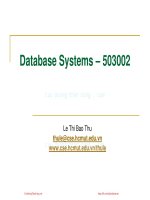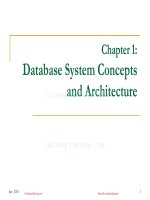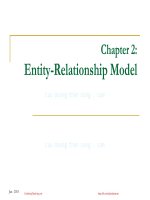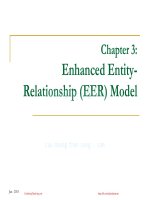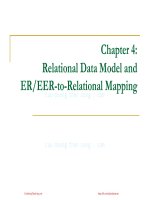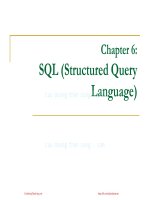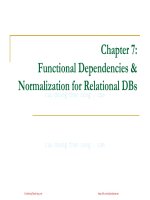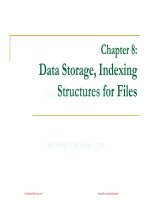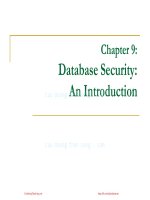cơ sở dữ liệu lê thị bảo thu chương ter 04 relationaldatamodelandrelationalmapping 2 sinhvienzone com
Bạn đang xem bản rút gọn của tài liệu. Xem và tải ngay bản đầy đủ của tài liệu tại đây (2.16 MB, 83 trang )
Chapter 4:
Relational Data Model and
ER/EER-to-Relational Mapping
CuuDuongThanCong.com
/>
Contents
1
Relational Data Model
2
Main Phases of Database Design
3
ER-/EER-to-Relational Mapping
Jan - 2015
CuuDuongThanCong.com
/>
2
Contents
1
Relational Data Model
2
Main Phases of Database Design
3
ER-/EER-to-Relational Mapping
Jan - 2015
CuuDuongThanCong.com
/>
3
Relational Data Model
Basic Concepts: relational data model,
relation schema, domain, tuple, cardinality &
degree, database schema, etc.
Relational Integrity Constraints
key, primary key & foreign key
entity integrity constraint
referential integrity
Update Operations on Relations
Jan - 2015
CuuDuongThanCong.com
/>
4
Basic Concepts
The relational model of data is based on the
concept of a relation
A relation is a mathematical concept based
on the ideas of sets
The model was first proposed by Dr. E.F.
Codd of IBM in 1970 in the following paper:
"A Relational Model for Large Shared Data
Banks," Communications of the ACM, June
1970
Jan - 2015
CuuDuongThanCong.com
/>
5
Basic Concepts
Relational data model: represents a database
in the form of relations - 2-dimensional table
with rows and columns of data. A database may
contain one or more such tables. A relation
schema is used to describe a relation
Relation schema: R(A1, A2,…, An) is made up
of a relation name R and a list of attributes A1,
A2, . . ., An. Each attribute Ai is the name of a
role played by some domain D in the relation
schema R. R is called the name of this relation
Jan - 2015
CuuDuongThanCong.com
/>
6
Basic Concepts
The degree of a relation is the number of
attributes n of its relation schema.
Domain D: D is called the domain of Ai and
is denoted by dom(Ai). It is a set of atomic
values and a set of integrity constraints
Jan - 2015
STUDENT(Name, SSN, HomePhone, Address,
OfficePhone, Age, GPA)
Degree = ??
dom(GPA) = ??
CuuDuongThanCong.com
/>
7
Basic Concepts
Tuple: row/record in table
Cardinality: number of tuples in a table
Database schema S = {R1, R2,…, Rm}
Jan - 2015
CuuDuongThanCong.com
/>
8
Basic Concepts
A relation r (or relation state, relation
instance) of the relation schema R(A1, A2, .
. ., An), also denoted by r(R), is a set of ntuples r = {t1, t2, . . ., tm}.
Jan - 2015
Each n-tuple t is an ordered list of n values t =
<v1, v2, . . ., vn>, where each value vi, i=1..n, is
an element of dom(Ai) or is a special null value.
The ith value in tuple t, which corresponds to the
attribute Ai, is referred to as t[Ai]
CuuDuongThanCong.com
/>
9
Basic Concepts
Relational data model
Database schema
Relation schema
Relation
Tuple
Attribute
Jan - 2015
CuuDuongThanCong.com
/>
10
Basic Concepts
A relation can be conveniently represented
by a table, as the example shows
The columns of the tabular relation represent
attributes
Each attribute has a distinct name, and is
always referenced by that name, never by its
position
Each row of the table represents a tuple. The
ordering of the tuples is immaterial and all
tuples must be distinct
Jan - 2015
CuuDuongThanCong.com
/>
11
Basic Concepts
Jan - 2015
CuuDuongThanCong.com
/>
12
Basic Concepts
Alternative Terminology for Relational Model
Formal Terms
Informal Terms
Relation
Table
Attribute
Column Header
Domain
All possible Column Values
Tuple
Row
Schema of a Relation
Table Definition
State of the Relation
Populated Table
Jan - 2015
CuuDuongThanCong.com
/>
13
Relational Integrity Constraints
Constraints are conditions that must hold on
all valid relation instances. There are three
main types of constraints:
Jan - 2015
Key constraints
Entity integrity constraints
Referential integrity constraints
CuuDuongThanCong.com
/>
14
Relational Integrity Constraints
Null value
Jan - 2015
Represents value for an attribute that is currently
unknown or inapplicable for tuple
Deals with incomplete or exceptional data
Represents the absence of a value and is not the
same as zero or spaces, which are values
CuuDuongThanCong.com
/>
15
Relational Integrity Constraints Key Constraints
Superkey of R: A set of attributes SK of R
such that no two tuples in any valid relation
instance r(R) will have the same value for
SK. That is, for any distinct tuples t1 and t2
in r(R), t1[SK] t2[SK]
Key of R: A "minimal" superkey; that is, a
superkey K such that removal of any attribute
from K results in a set of attributes that is not
a superkey
Jan - 2015
CuuDuongThanCong.com
/>
16
Relational Integrity Constraints Key Constraints
Example: The CAR relation schema:
CAR(State, Reg#, SerialNo, Make, Model, Year) has two
keys
Key1 = {State, Reg#}
Key2 = {SerialNo}, which are also superkeys. {SerialNo,
Make} is a superkey but not a key
If a relation has several candidate keys, one
is chosen arbitrarily to be the primary key.
The primary key attributes are underlined.
Jan - 2015
CuuDuongThanCong.com
/>
17
Relational Integrity Constraints Key Constraints
The CAR relation, with two candidate keys:
License_Number and Engine_Serial_Number
Jan - 2015
CuuDuongThanCong.com
/>
18
Relational Integrity Constraints Entity Integrity
Relational Database Schema: A set S of relation
schemas that belong to the same database. S is the
name of the database: S = {R1, R2, ..., Rn}
Entity Integrity: primary key attributes PK of each
relation schema R in S cannot have null values in
any tuple of r(R) because primary key values are
used to identify the individual tuples: t[PK] null for
any tuple t in r(R)
Jan - 2015
Note: Other attributes of R may be similarly
constrained to disallow null values, even though they
are not members of the primary key
CuuDuongThanCong.com
/>
19
Relational Integrity Constraints Referential Integrity
A constraint involving two relations (the previous
constraints involve a single relation)
Used to specify a relationship among tuples in two
relations: the referencing relation and the referenced
relation
Tuples in the referencing relation R1 have attributes FK
(called foreign key attributes) that reference the primary
key attributes PK of the referenced relation R2. A tuple t1
in R1 is said to reference a tuple t2 in R2 if t1[FK] = t2[PK]
A referential integrity constraint can be displayed in a
relational database schema as a directed arc from R1.FK
to R2
Jan - 2015
CuuDuongThanCong.com
/>
20
Relational Integrity Constraints Referential Integrity
Jan - 2015
CuuDuongThanCong.com
/>
21
Relational Integrity Constraints Referential Integrity
Statement of the constraint
The value in the foreign key column (or
columns) FK of the the referencing relation
R1 can be either:
(1) a value of an existing primary key value of the
corresponding primary key PK in the referenced
relation R2,, or
(2) a NULL
In case (2), the FK in R1 should not be a part
of its own primary key
Jan - 2015
CuuDuongThanCong.com
/>
22
Referential integrity constraints displayed on the
COMPANY relational database schema
Jan - 2015
CuuDuongThanCong.com
/>
23
Relational Integrity Constraints Other Types of Constraints
Semantic Integrity Constraints:
-
based on application semantics and cannot be
expressed by the model per se
E.g., “the max. no. of hours per employee for all
projects he or she works on is 56 hrs per week”
A constraint specification language may have to
be used to express these
SQL-99 allows triggers and ASSERTIONS to
allow for some of these
State/static constraints (so far)
Transition/dynamic constraints: e.g., “the
salary of an employee can only increase”
Jan - 2015
CuuDuongThanCong.com
/>
24
Update Operations on Relations
INSERT a tuple
DELETE a tuple
MODIFY a tuple
Integrity constraints should not be violated by
the update operations
Jan - 2015
CuuDuongThanCong.com
/>
25
